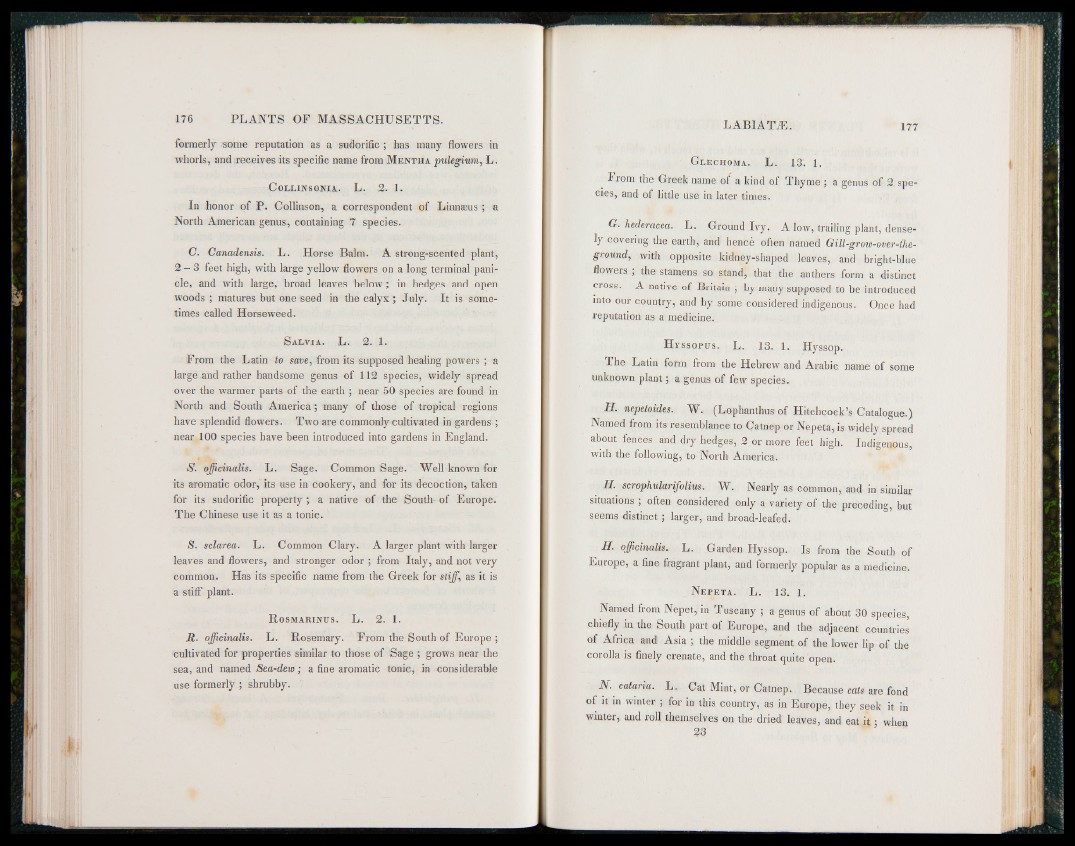
formerly some reputation as a sudorific ; has many flowers in
whorls, and receives its specific name from Mentha pulegium, L .
C ollins onia. L. 2. 1.
In honor of P. Collinson, a correspondent of Linnaeus ; a
North American genus, containing 7 species.
C. Canadensis. L. Horse Balm. A strong-scented plant,
2 — 3 feet high, with large yellow flowers on a long terminal panicle,
and with large, broad leaves ‘below; in hedges and open
woods ; matures but one seed in the calyx ; July. It is sometimes
called Horse weed.
S alvia. L. 2 ,1.
From the Latin to save, from its supposed healing powers ; a
large and rather handsome genus of 112 species, widely spread
over the warmer parts of the earth ; near 50 species are found in
North and South America ; many of those of tropical regions
have splendid flowers. Two are commonly cultivated in gardens ;
near 100 species have been introduced into gardens in England.
S. officinalis. L. Sage. Common Sage. Well known for
its aromatic odor, its use in cookery, and for its decoction, taken
for its sudorific property ; a native of the South of Europe.
The Chinese use it as a tonic.
S. sclarea. L. Common Clary. A larger plant with larger
leaves and flowers, and stronger odor ; from Italy, and not very
common. Has its specific name from the Greek for stiff, as it is
a stiff plant.
R osmarinus. L. 2. 1.
R. officinalis. L. Rosemary. From the South of Europe ;
cultivated for properties similar to those of Sage ; grows near the
sea, and named Sea-dew; a fine aromatic tonic, in considerable
use formerly ; shrubby.
G lechoma. L. 13. 1.
_ ■From Greek name of a kind of Thyme ; a genus of 2. species,
and of little use in later times.
G. hederacea. L. Ground Ivy. A low, trailing plant, densely
covering the earth, and hence often named Gill-grow-over-ihe-
ground, with opposite kidney-shaped leaves, and bright-blue
flowers ; the stamens so stand, that the anthers form a distinct
cross. A native of Britain ; by many supposed to be introduced
into our country, and by some considered indigenous. Once had
reputation as a medicine.
Hrssopus. L. 13. 1. Hyssop.
The Latin form from the Hebrew and Arabic name of some
unknown plant; a genus of few species,
H. nepetoides. W. (Lophanthus of Hitchcock’s Catalogue.)
Named from its resemblance to Catnep or Nepeta, is widely spread
about fences and dry hedges, 2 or more feet high. Indigenous,
with the following, to North America.
H. scrophularifolius. W. Nearly as common, and in similar
situations ; often considered only a variety of the preceding, but
seems distinct; larger, and broad-leafed.
H. officinalis. L. Garden Hyssop. Is from the South of
Europe, a fine fragrant plant, and formerly popular as a medicine.
N e p e t a . L. 13. 1.
Named from Nepet, in Tuscany ; a genus of about 30 species,
chiefly in the South part of Europe, and the adjacent countries
of Africa and Asia ; the middle segment of the lower lip of the
corolla is finely crenate, and the throat quite open.
N- c at aria. L , Cat Mint, or Catnep, Because cats are fond
of it in winter ; for in this country, as in Europe, they seek it in
winter, and roll themselves on the dried leaves, and eat it ; when
33